A review of ‘Acts at the Crossroads’, a long overdue and crucial survey of Otobong Nkanga’s practice in a museum exhibition on the African continent.
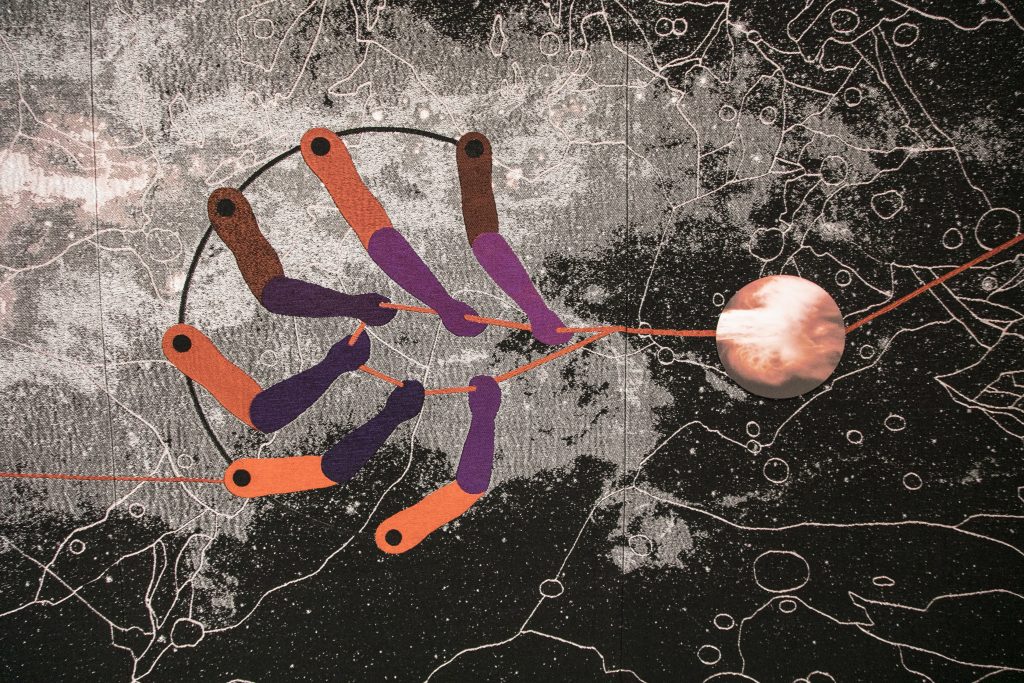
Superbly co-curated by Koyo Kouoh and Precious Mhone, and presented on the second floor of the Zeitz Museum of Contemporary Art Africa (Zeitz Mocaa), Cape Town, Acts at the Crossroads is Otobong Nkanga’s first museum exhibition on the African continent. The exhibition is a long overdue and crucial survey of Nkanga’s pluri-disciplinary practice that causes the viewer to be confronted with a certain fragility. Acts at the Crossroads highlights the last twenty years of the artist’s practice. A practice that has continued to broaden in its disciplinary scope and resist fixed boundaries through its depth and complexity.
In the past two decades, Nkanga has developed a practice that is firmly grounded in the use of material forms to interpret the outside world. She has perpetually challenged the viewer to critically reflect on their relationship with the natural environment and encouraged them to interrogate the oppressive man-made economic systems of the capitalist era that we are so intricately bound to. Nkanga makes explicit the serious threat that these industrial configurations have on our existence and the future of the planet at large.
In Acts at the Crossroads we are invited into a celestial pilgrimage through the artists intellectual meditations and practice. The works on view range from poetry to photography, painting, lithography, and drawing; extending to video, installation art, textiles and other mixed media interventions. They combine to address the ‘instability of cultural identity’ through the exploration of postcolonial consequences, while also prompting the viewer to question how we experience our immediate surroundings. The artist sensibly appropriates and poetically incorporates these ideas into her expressions. She constructs personal narratives that dwell on memory, environment, and the postcolonial histories embedded in her home country Nigeria. Despite garnering so much acclaim in the Global North, Nkanga continues to be greatly interested in matters relating to the socio-economic development of the African continent. She has consciously managed to do this through her art practice. A key component of which is an interest in how art can be seen to have a functional purpose in our social world. As an overview of her body of work, the works in this survey exhibition provide an insight into the complicated geographical, historical and affective engagements that she has immersed herself within her practice. She portrays to us the pernicious neoliberal formations caused by the demands of global capital in the postcolonial era, showing us the discernible movement of economic goods and services from one geographical point on the planet to another.
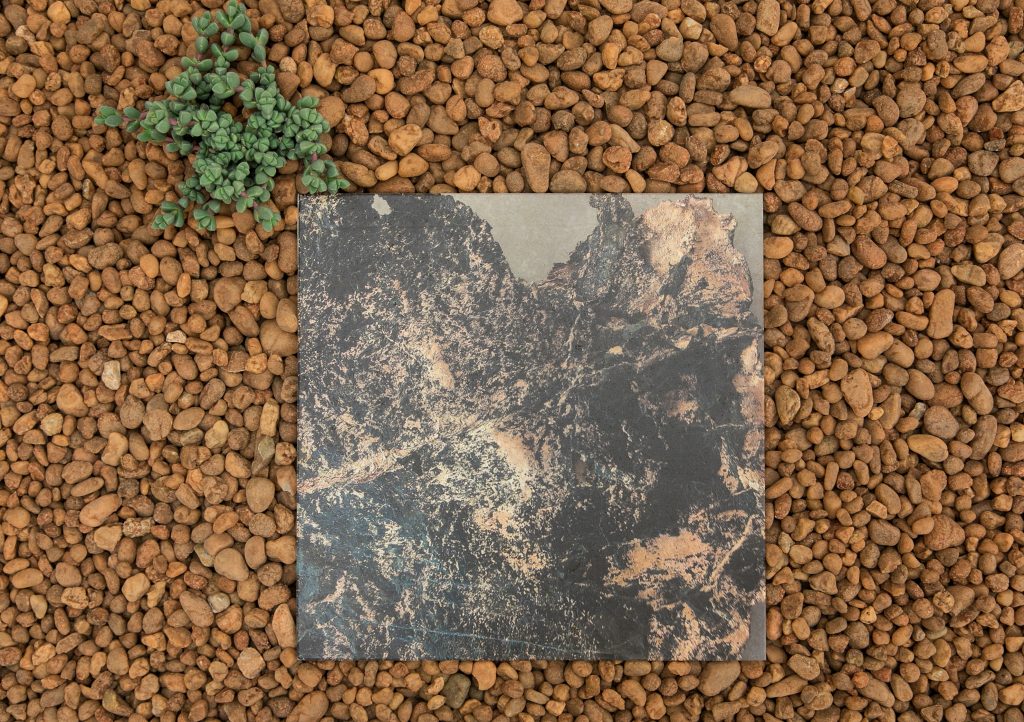
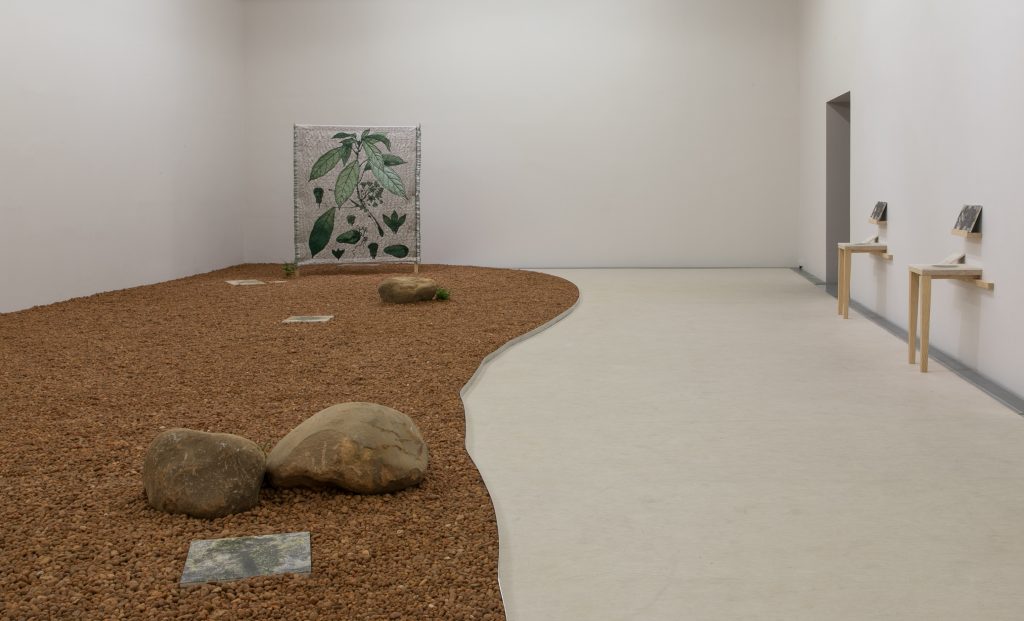
In the work Carved to Flow, which is not featured in this survey, Nkanga created a three-phase artwork where she developed a cold press recipe for making soap. The artwork had a site-specific, performative and functional component. In the third stage of the artwork called Germination, Nkanga created the Carved to Flow Foundation that is based in Akwa Ibom, Nigeria. The foundation is dedicated to researching material cultures and fostering shared experimentation that focus on modes of circulation occuring on a local circuit in the region in which the foundation is situated. In the manufacturing of the soap itself various kinds of oils, butter and charcoals coming from the Mediterranean, Middle East, and North and West Africa were used. The soap became a material protagonist to contemplate on the social, economic and conceptual convergence of organic and inorganic materials from these four geographical regions.
The notions of merger and separation, convergence and divergence are central to understanding the essence of Nkanga’s art practice. In the selection and narration of the exhibition, points of connectivity and collision are important themes that are evident throughout the show. The exhibition opens with a piece from the 2012 – 2014 photographic series titled Shaping Memory. Shaping Memory is a lambda c-type print edition color photograph that is 120 x 90 cm in size. It is an image taken in Nigeria by Nkanga. In the image, she uses the medium of photography to reflect on the use and cultural value connected to natural resources. She explores how meaning and function are relative within cultures, and how an individual product might comprise multiple roles and histories, particularly within the context of the artist’s memory. In another photographic series titled Things Have Fallen (2004/5) and Emptied Remains – Assemblage (2010), Nkanga references West African cultural artifacts, architecture and landscape and situates them in a political web of Nigeria’s postcolonial economy. Raising questions about the cultural, ethnographic, and use value of these items, she creates landscapes and corporeal forms with clean, hard-edged lines that address the political and ecological impacts of Nigeria’s oil industry.
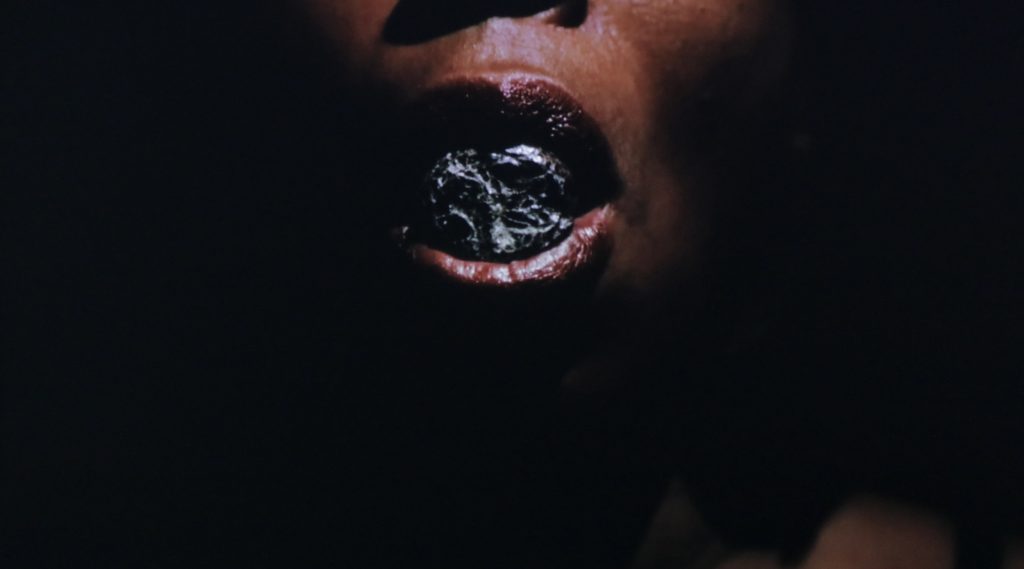
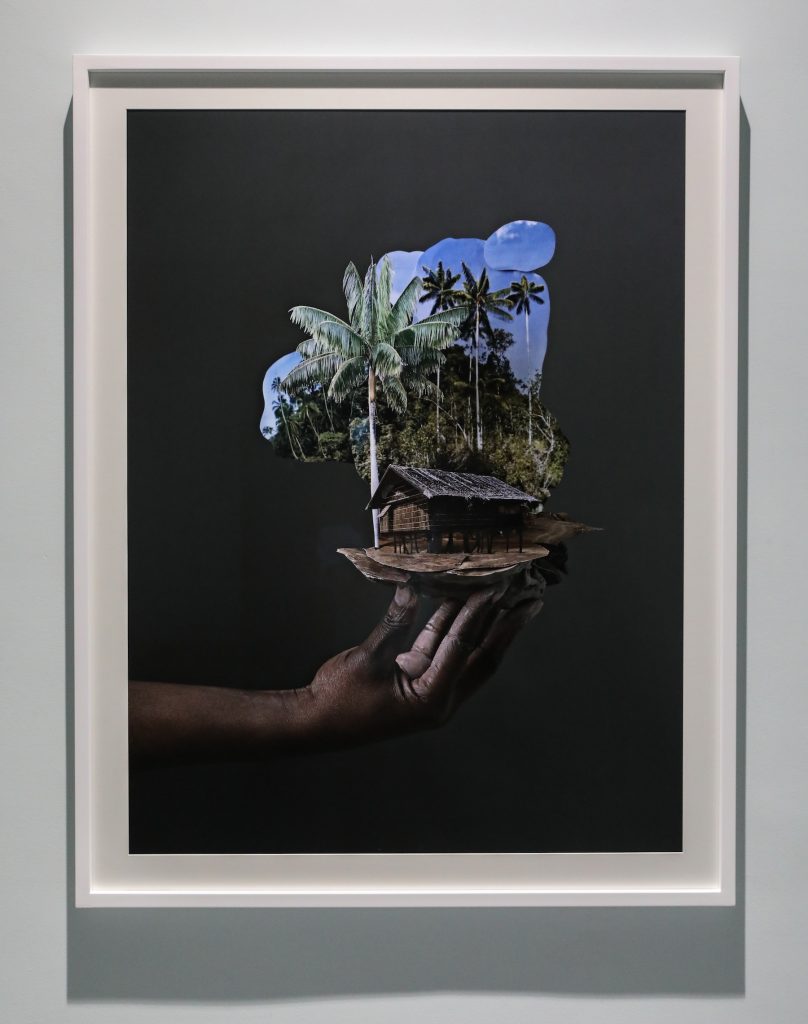
Adjacent to these series of photographs are Nkanga’s paintings and drawings. Some frequently recurring elements in the drawings refer to landscapes and maps, needles, colour samples and bodies or ‘body parts turning into something else’. In her drawings, Nkanga examines or describes elements that cannot be captured in words. Quite often, the drawings also serve as a preliminary study, or they are a by-product of her performances. The needles that seem to be a recurrent motif in many of her drawings represent the desire of people to subdue the earth to their will. In the past, emissaries from western empires travelled around the world and planted flags everywhere. They appropriated territories without any consultation with the indigenous population. A needle on a world map indicated their property. There is a particularly intriguing work titled Social consequences II: The Overload – Projectiles – Piercing Pressure – Hostage Wastescape – The Overflow, a painting piece made in 2009 from acrylic and stickers on paper that examines the socio-political impacts of industrialisation and exposes the global capitalist industries that feeds its own stages of production, renders human capital into dispensable labour and mere instruments of wealth accumulation. The colour samples, which are often applied to the drawing, show the starting point of the work. From this patchwork of colours, the drawing is put in motion.
In the installation Taste of a Stone (2010) Nkanga sourced materials that could speak to local histories which converge into the locale of the Cape, where the exhibition is showing. As we enter the space we encounter an all-encompassing sensorial experience of the materials by stepping onto the floor; the sights, smells, sounds and texture underfoot reconnect us with nature. In this particular instance of the installation she selects Namib red stones, boulders from Tulbagh, Galala limestone slabs (of Egyptian origin) and a host of South African indigenous plants, shrubs and succulents. She uses the stones as part of a larger phenomenal narrative including her poetry. Nkanga prefers the spoken word — the traditions of the griot, the storyteller, the advisor, the poet, the orator, but also the open-ended evolution of conversation and all forms of ephemeral verbalised exchange. Positioned in the installation is a tapestry with the reoccurring image of the Kola nut plant. The Kola nut is not only a spiritual object but a ritual used in trade practices in West Africa. Nkanga explained that the Kola tree is important for its culture and is a symbol of spirituality to its culture. These elements, a brown nut (Cola acuminata) or a cream butter (Cola nitida) existed for preparing a conversation. When they are ingested the caffeine diffuses into the body, vitalising it and creating a bond between the traders. She perceives the practice as a performative custom that is an important facet in the social formation of West African cultural identity across the region. She also considers our ability to taste, experience or connect with these materials noting the rituals of consumption and exchange between communities and spaces.
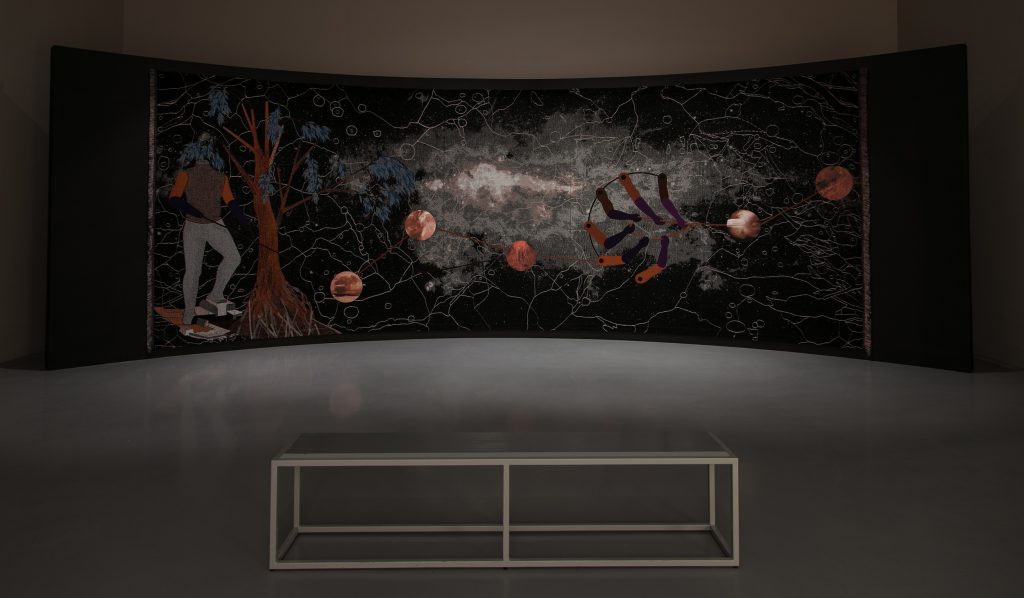
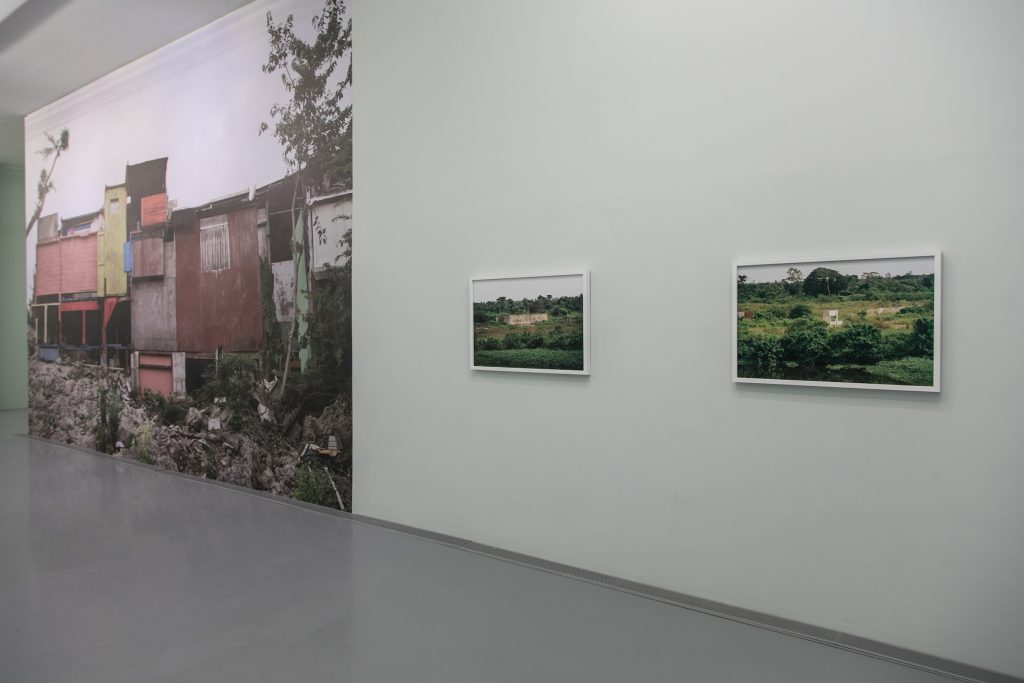
Another work in the survey, Double Plot (2018), is a woven textile with photography that is 265 x 770 cm and occupies the same space as a piece titled In a Place Yet unknown (2017), created from woven textile, copper metal container, inks and dyes. Double Plot is a contemplation on the ways that people are removed from their natural environment and the impact that industrial exploitation has on the land. It explores the interconnected relationship between nature, cosmology, humankind and spiritual practice. In the background of the piece is depicted a mapping of galactical constellations beneath a series of nebula, interstellar and astronomical phenomenon. There is a reference to the attraction and repulsion caused by interplanetary forces including our planets role within a larger solar system. The galactical constellation represented on the tapestry can be imagined to be a re-mapping of the constellation of the southern skies by Nkanga. Astronomer and photography pioneer John Herschel came to Cape Town in the 1900s and proceeded to conduct a mapping of the star constellations in the Southern Hemisphere. From this mapping made by Hershel emerged the topographical creation and mapping of national borders of countries in the Southern Hemisphere. We have seen that the imposition of national borders by imperialists on the African continent has deepened the divisions amongst Africans and facilitated the expansion of the colonial project. Double Plot could be envisioned as Nkanga’s provocation to us to start living according to the maps of the skies rather than the colonial maps that are stifling movement and socio-economic development on the continent.
The socio-cultural processes of exchange are important in the construction of Nkanga’s imaginative economies. She is conscious of the connectedness of the story of economic production in formation of contemporary society. The motif of the robotic limbs that resemble tools of mechanised labour represents the becoming technical of the human being. The artwork contemplates the renewal of understanding among people and the complex relationship between civilisation, spirituality and the universe. In the video piece titled Pursuit of Bling (2014) she explores the use of minerals in relation to the body. The Pursuit of Bling is the confluence of several research avenues into the numerous metamorphoses that natural resources undergo during their transition from raw material to finished product. The video depicts a rock called mica which derives its name from the Latin macre, meaning ‘to shimmer’ or ‘to glitter’. Mica is a mineral that is used for a wide range of purposes, including the production of cosmetics. In the video Nkanga performs acts exploring the surface characteristics of rock using her own body as an instrument of interpretation. These minerals are objects to be desired, they provide a sparkle to shroud and beautify the skin but are also talismans for healing and restoration. As part of the performance, she ingests the mineral, almost as a pill, to absorb its magic. In addition to the mineral story and references to history in general, the installation embodies the striving for a better and prettier version of ourselves.
The entire survey, Acts at the Crossroads, gives us a visualization of the practice of an artist that has over time proven to be very penetrative and refuses to be confined within boundaries. It sits well within the museum and welcomes visitors into a focused space where they are expected to interact with the art. In this regard, the exhibition beautifully implores us to think with and through space but also probes us to think beyond the space of the museum and expand our conception of borders by seeing ourselves in the world and the world in us.
_
Phokeng Setai is an independent curator, writer and fellow at The Flagship on Critical Thought in African Humanities of the Centre for Humanities Research (CHR) at the University of the Western Cape (UWC), living in Cape Town, South Africa. Setai is interested in the post-colonial condition and believes art plays an integral role in the stitching of societal dissonances at the heart of contemporary social life.




